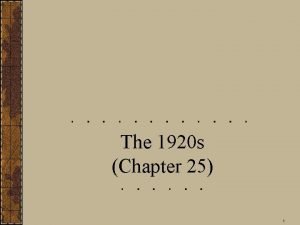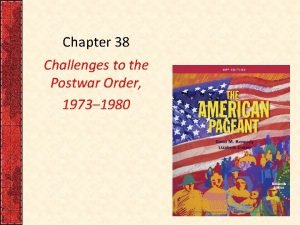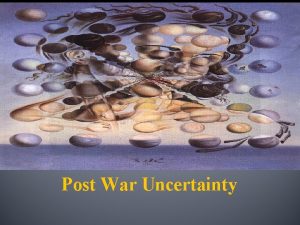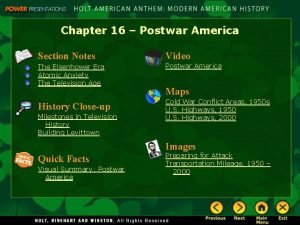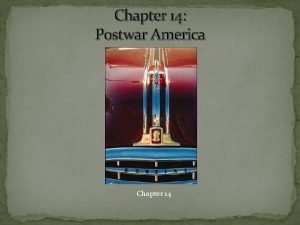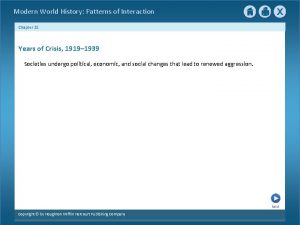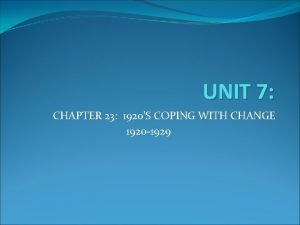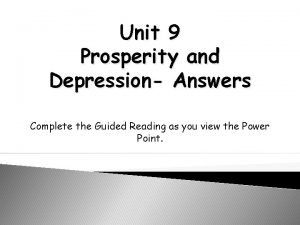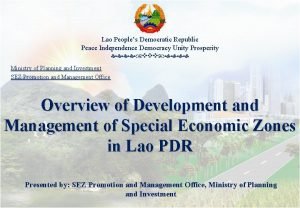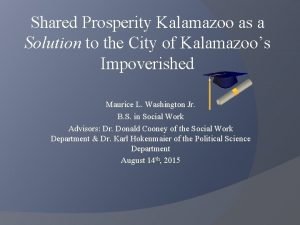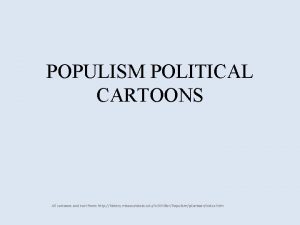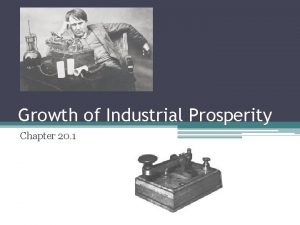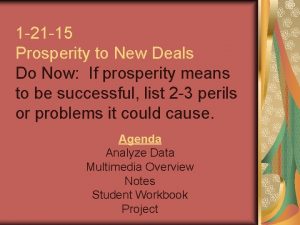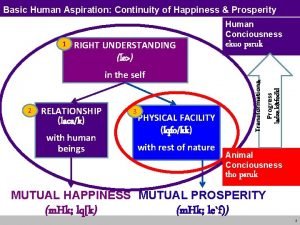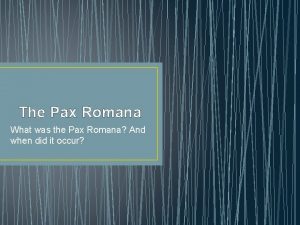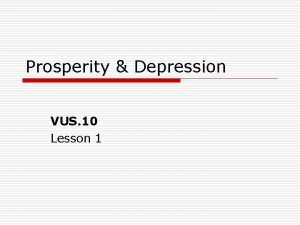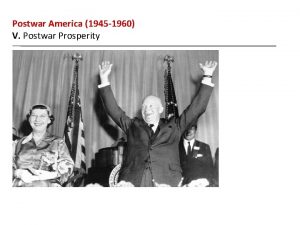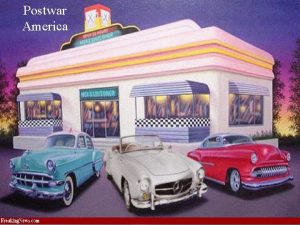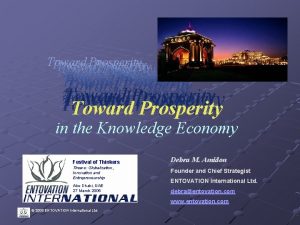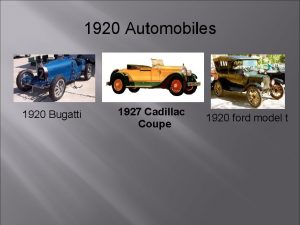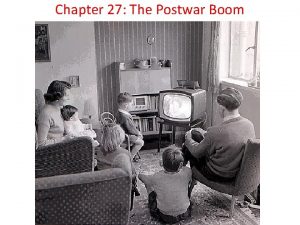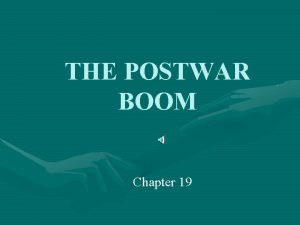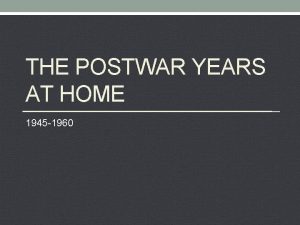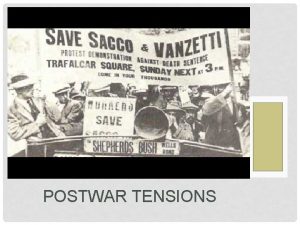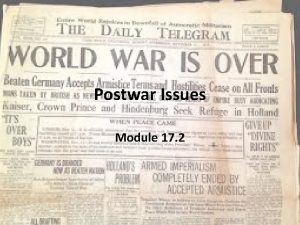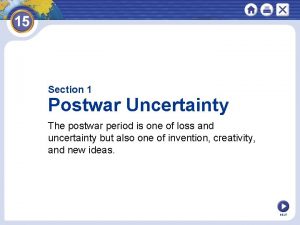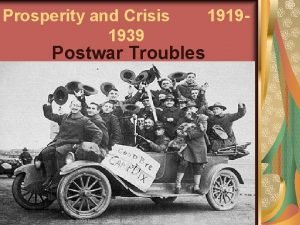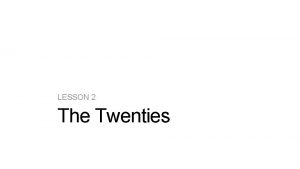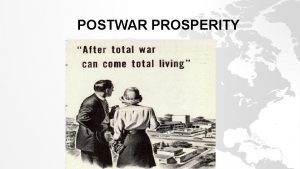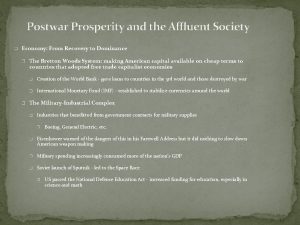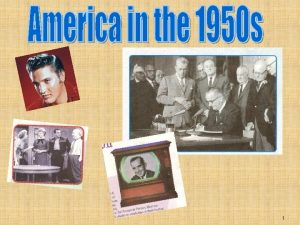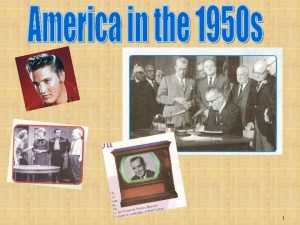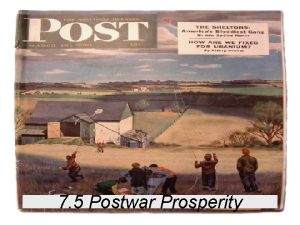The 1920 s Chapter 25 1 Postwar Prosperity

























- Slides: 25

The 1920 s (Chapter 25) 1

Postwar Prosperity and Its Price 2

Summary of the 1920 s A time of great excitement & rapid changes. Women’s suffrage, Flappers, Ford cars, the Harlem Renaissance, & new technologies A time of great fear & apprehension. Fear of communism, immigrants, & alcohol fueled feelings of mistrust, hatred, & unlawful behavior. Started out slowly, grew into a period of great prosperity (despite concerns in the agricultural sector) until the stock market crashed in 1929. 3

Consumer Debt, 1920– 31 The expansion of consumer borrowing was a key component of the era’s prosperity. These figures do not include mortgages or money borrowed to purchase stocks. They reveal the great increase in “installment buying” for such consumer durable goods as automobiles & household appliances. 4

The Auto Age Cars symbolized the rise of the consumer economy. 85% of cars were made in the USA The auto industry spurred production of steel, rubber, glass, & petroleum. Road building triggered commercial development along highways, promoted new businesses & changed social habits. Henry Ford paid his workers more than the going rate, reducing turnover & enabling them to be both producers & consumers of his Model T. The car cost $290 ~3 month’s wages. 5

Cities & Suburbs The automobile people move to suburbs. Cities grew at a fast pace, horizontally & vertically - new buildings reshaped the skyline. Seattle skyline from West Seattle with Smith Tower in the background. 6

The New Mass Culture 7

Movies - America’s most popular form of the new mass culture. A huge, national audience regularly attended movies in grand, majestic theaters. Publicists created an elegant image for movie stars. The production center was Hollywood, California. Coliseum Theatre, 5 th & Pike 8

Radio Broadcasting The nation’s 1 st comprehensive mass entertainment medium. National networks aired a variety of programs. (NBC, CBS) Radio helped to commercialize previously isolated forms of music & build a mass following for sports. 9

New Forms of Journalism The 1920 s saw the growth of newspaper tabloids - emphasizing crime, sex scandals, gossip columns, & sports. 10

Advertising Modernity Advertising became a thriving industry, promoting consumerism. Agencies employed market research to stress consumer needs, desires, & anxieties rather than the qualities of the product – marketing. Consumption seen as a positive good. A 1919 advertisement for Lucky Strike cigarettes featured the image of actress Billie Burke. Paid celebrity endorsements became a common practice in the post WWI years. Tobacco companies were among the most aggressive purveyors of this new advertising strategy. 11

Sports & Celebrity Spectator sports reached unprecedented popularity athletes took on a celebrity status. Attendance soared, prompting newspapers & radio stations to broaden their coverage – Baseball was #1 sport. African Americans were excluded from major league baseball - the Negro National League (organized in 1920) provided new opportunities. Babe Ruth, baseball’s biggest star, shakes hands with President Warren G. Harding at the Opening Day of the brand new Yankee Stadium, Bronx, New York, April 4, 1923. 12

The Pittsburgh Crawfords, one of the most popular and successful baseball teams in the Negro National League, organized in 1920. Excluded from major league baseball by a “whites only” policy, black ballplayers played to enthusiastic crowds of African Americans from the 1920 s through the 1940 s. The “Negro leagues” declined after major league baseball finally integrated in 1947. 13

The “New Negro” Black hope & pride in individual & collective identity, a refusal to submit quietly to the practices & laws of Jim Crow segregation. The Great Migration African Americans continued to migrate to northern urban communities. The Harlem Renaissance Harlem became a major African. American cultural center as a wide range of artists explored aspects of black life in new ways. • Most Harlem residents worked long hours at menial jobs for low pay. Marcus Garvey emphasized black pride, self-help, blackowned businesses, & unity among all people of African descent. 14

A New Morality? For some people the 1920 s saw a new morality symbolized by the flapper who danced to jazz, smoked cigarettes, drank bootleg liquor, & was sexually active. Surveys of sexual behavior showed that an increased number of women had sexual relations prior to marriage. The new morality was reflected in American popular culture. 15

Alienated Intellectuals Gertrude Stein described intellectuals of the 1920 s as a “lost generation. ” Authors: expressed cynicism about society’s goals & purposes. questioned the crass materialism of the opulent rich. mocked the values of small town America. 16

Modernity vs. Traditionalism 17

Prohibition A way to restore public morality, but public demand for alcohol remained strong. Bootlegging provided a great boost to organized crime, which became a permanent feature of American life. 18

Immigration Restriction The movement to restrict immigration of southern & eastern Europeans accelerated. Backed by recurring American beliefs in racial inferiority, & fueled by wartime patriotism, the Red Scare, & nativist sentiment, legislation passed that set quotas on annual immigration. 19

The Ku Klux Klan Most mainstream nativist organization. Two Themes: Immigrant Restriction White Supremacy Hiram W. Evans transformed it into a mass movement using modern promotional techniques. Mostly white Protestant middle-class men & women, saw themselves as moral & religious crusaders, vigilantes restoring justice. They used intimidation, threats of violence, & actual violence to intimidate African Americans, immigrants, Catholics, Jews, liberals, & progressives. 20

The Ku Klux Klan The Klan claimed millions of members & was a powerful force in Democratic Party politics in the South & in several western & Midwestern states. 1925 - the Klan faded, in part due to a scandal that discredited one of its leaders. (He raped & murdered a woman) 21

Women members of the Ku Klux Klan in New Castle, Indiana, August 1, 1923. The revived Klan was a powerful presence in scores of American communities, especially among native-born white Protestants, who feared cultural and political change. In addition to preaching “ 100 percent Americanism, ” local Klan chapters also served a social function for members and their families. 22

Black Population, 1920 Although the Great Migration had drawn hundreds of thousands of African Americans to the urban North, the Southern states of the former Confederacy still remained the center of the African American population in 1920. 23

Religious Fundamentalism Religious fundamentalism paralleled political nativism. Fundamentalists rejected the tenets of modern science, particularly evolution. 5 states banned its teaching in public schools. William Jennings Bryan & Clarence Darrow squared off in the Scopes trial in Dayton, Tennessee. 24

Signs of Prosperity & Trouble Prosperity Standard of living rose Cities grew Larger # of men & women working in office jobs Emphasis on marketing of consumer goods Growing investment in Stock Market Assembly line – families purchased autos Children 10 -15 working in industry declined Trouble Farmers in Midwest & South were least prosperous Falling prices for agricultural products Rising consumer debt 25
 Chapter 14 postwar prosperity and civil rights
Chapter 14 postwar prosperity and civil rights Impressionism apush
Impressionism apush Chapter 38 challenges to the postwar order
Chapter 38 challenges to the postwar order Chapter 31 section 1 guided reading postwar uncertainty
Chapter 31 section 1 guided reading postwar uncertainty Chapter 19 section 1 postwar america
Chapter 19 section 1 postwar america Chapter 16 postwar america
Chapter 16 postwar america Lesson 1 truman and eisenhower
Lesson 1 truman and eisenhower Chapter 15 section 2 world history
Chapter 15 section 2 world history Chapter 23 activity: coping with change, 1920-1929
Chapter 23 activity: coping with change, 1920-1929 Prosperity and depression worksheet answers
Prosperity and depression worksheet answers Prosperity oil
Prosperity oil Mascot international (lao) sole co. ltd
Mascot international (lao) sole co. ltd Basic requirements for fulfilling the basic aspiration
Basic requirements for fulfilling the basic aspiration The growth of industrial prosperity
The growth of industrial prosperity Shared prosperity kalamazoo
Shared prosperity kalamazoo Populism political cartoon
Populism political cartoon The growth of industrial prosperity lesson 1
The growth of industrial prosperity lesson 1 Prosperity deals
Prosperity deals The four laws of financial prosperity
The four laws of financial prosperity Simplicity is prosperity
Simplicity is prosperity Mexiplex
Mexiplex Boom recession depression recovery
Boom recession depression recovery I aspire for happiness and prosperity in continuity
I aspire for happiness and prosperity in continuity Prosperity in the pax romana diagram
Prosperity in the pax romana diagram Prosperity and depression worksheet answers
Prosperity and depression worksheet answers People planet prosperity
People planet prosperity
